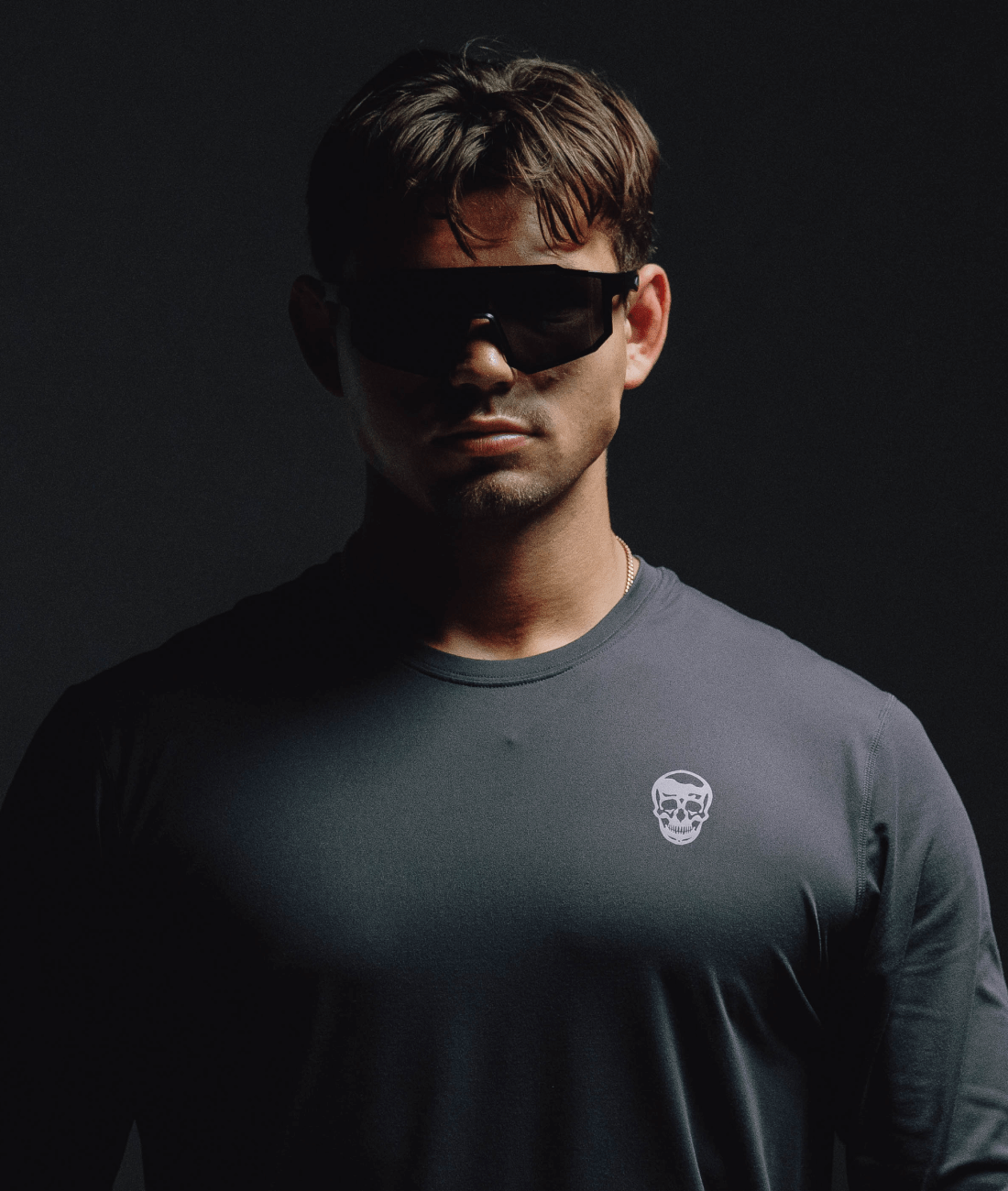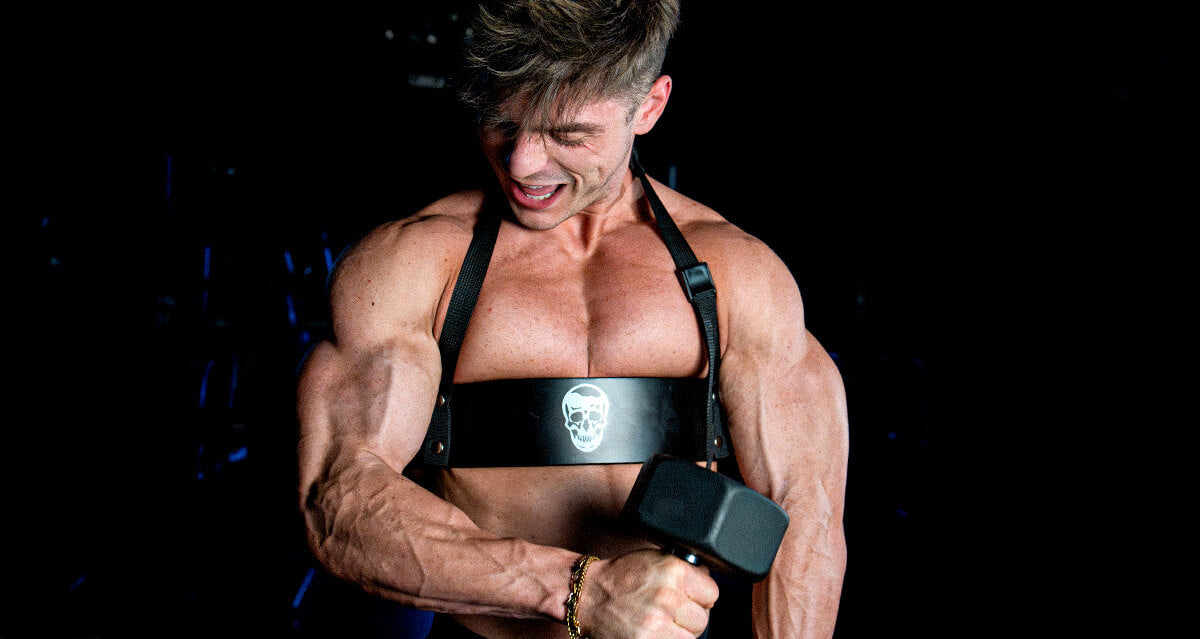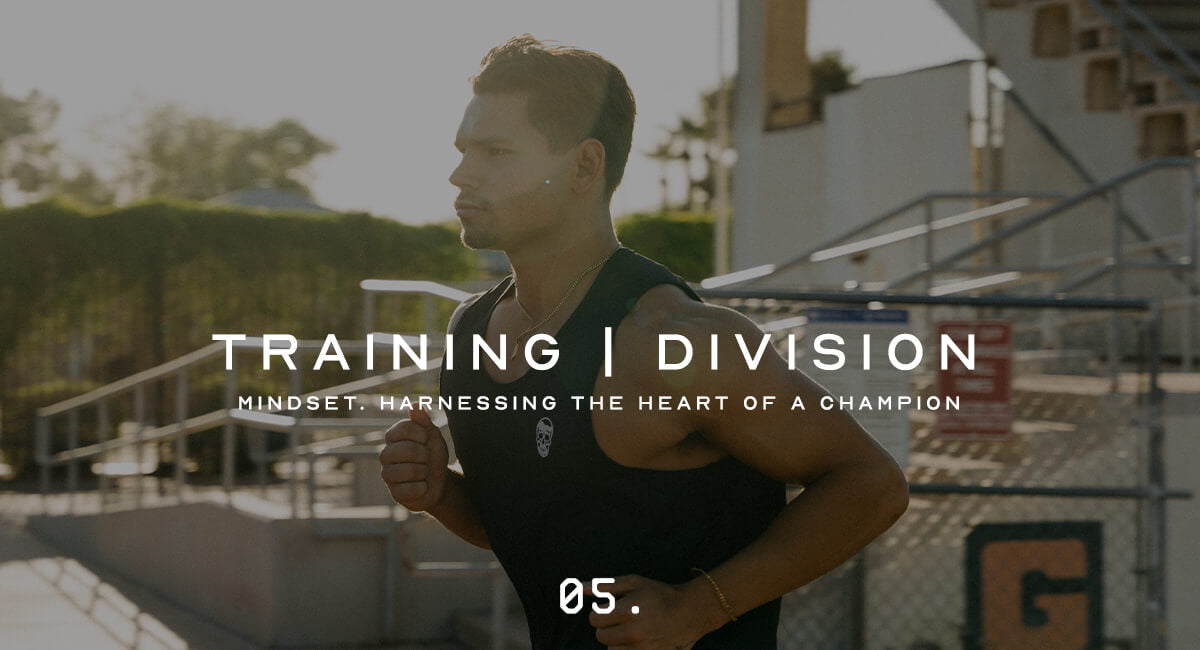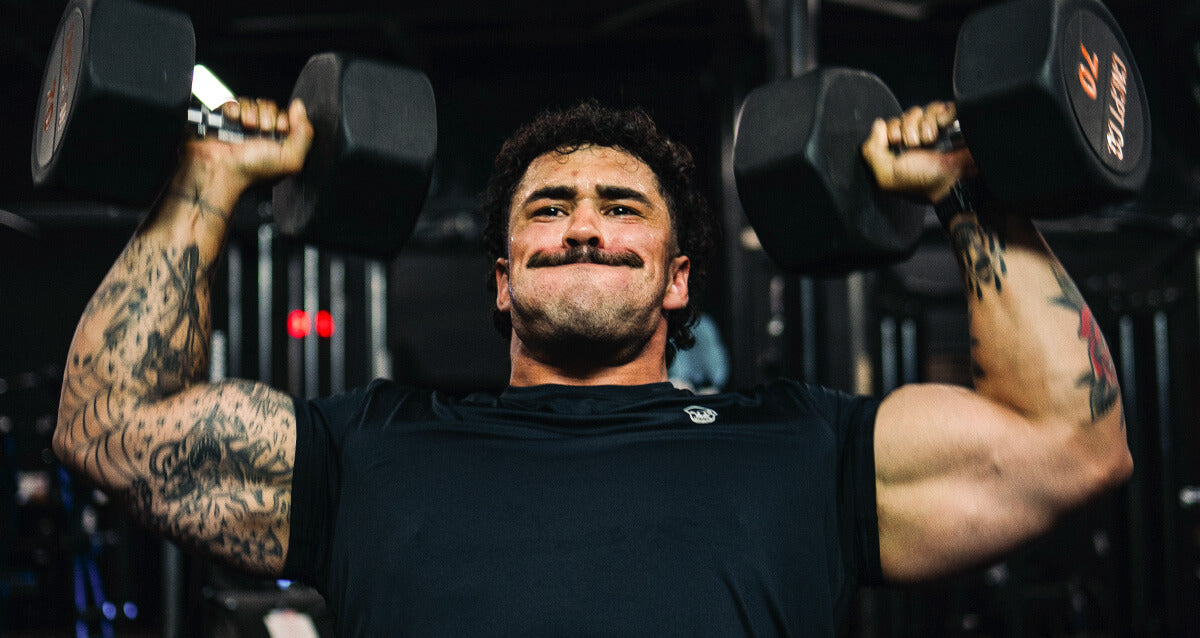Pairing your chest and bicep training is what you need to maximize upper body growth by limiting fatigue.
I’ll walk you through the best chest and bicep exercises and teach you how to build the ultimate workout.
Key Takeaways
Benefits of Training Chest & Biceps Together
The benefits of training chest and biceps together are:
Fresh Arms for Isolation Training
Training biceps with chest allows you to attack biceps from a fresh poison every workout. If you pair the biceps with the back or triceps with the chest, the smaller arm muscles will start their first primary exercise in a fatigued state as they assist the larger muscle group in its exercises.
Fatigue is the limiting factor for those struggling to gain size in the muscle group trained second in the session.
Balance Workout Intensity
Since biceps and chest do not assist one another during their primary movements, you can often maintain a higher workout intensity as training one does not negatively impact your ability to push hard on the other.
Workout Efficiency
Training one large muscle group (like the chest) and one smaller muscle group (like the biceps) allows you to complete workouts faster than training multiple large muscle groups in one day.
This strategy is ideal if you are short on time in a single session but can still work out often enough through the week to train all muscle groups 1-2 times a week (this usually requires you to train 4-6 workouts a week).
Key Chest Exercises
Below are nine of the top chest exercises you should be doing to prioritize muscle growth.
1. Barbell Flat Bench Press
The barbell bench press is an iconic chest builder, allowing you to subject the chest muscles to heavy loads and create a high force on the muscle. This exercise is also widely used to promote strength as well.
How To
- Lie on a bench with your hips, upper back, and shoulders on the pad. Plant your feet on the ground below your hips.
- With your chest high, unrack the bar and stabilize it over your shoulders. Then, slowly lower the weight to the sternum, actively pulling the elbows towards the floor.
- Touch the chest under control, making sure not to bounce or use momentum, and then press the weight back up while keeping your chest up and back slightly arched.
Expert Tip: Too many lifters focus on lifting the weight, but in reality, lowering the weight under control and getting a deep stretch on the pecs is critical for growing a bigger chest. Lower slowly, focusing on resisting gravity on the way down.
Why You Should Use Wrist Wraps for Bench Press
Gymreapers Wrist wraps are a simple yet effective way to improve your bench press. They add stability to your wrists, reducing strain and helping you maintain proper alignment under heavy loads. This lets you concentrate on pressing the weight without worrying about wrist discomfort or losing form. Additionally, wrist wraps help prevent injuries by providing essential joint support, making them a valuable tool for anyone focused on building strength and muscle.
2. Barbell Incline Bench Press
The barbell incline bench press targets the upper chest fibers and is performed with an incline of 15-45 degrees.
How To
- Set an adjustable bench to an incline of 15-45 degrees, and place your hips, back, and head firmly on the bench with your feet under your hips.
- Keeping your chest high, unrack the bar and stabilize it over your shoulders. Then, slowly lower the weight to the upper chest just below the clavicle, pulling the elbows towards the floor.
- Touch the upper chest and maintain tension to avoid bouncing the weight off the chest or lifting the hips, and then press the weight back up to the start position.
Expert Tip: Play around with angles, as I find significant growth in going from 15 to 30 degrees, 30 to 45, and 54 to 15. You can use slight tweaks in angles to see what feels best and then cycle through angles for continual gains.
For example, 4 weeks at 15 to 30 degrees followed by 4 weeks at 30 to 35 degrees to change the stimulus.
3. Dumbbell Flat Bench Press
The dumbbell flat bench is another excellent chest exercise. It can help address any muscle asymmetries between your left and right pecs. Additionally, you can get a deeper stretch at the bottom of the press, which can help you grow.
How To
- Lie on a flat bench with your feet planted on the floor and back slightly arched.
- With dumbbells pressed above your shoulders, keep the chest up and pull the elbows towards the floor, opening the dumbbells wide enough so that the dumbbell touches your outer chest.
- Press back up, keeping your back head, upper back, and hips on the bench (and feet on the floor).
Expert Tip: In the bottom position, your elbows should be 45-70 degrees from your body. If you are too flared (e.g., 90 degrees), you will feel shoulder discomfort and increase your risk of injury. If you experience discomfort regardless of the angle, try this neutral grip dumbbell bench press variation (or go lighter and slow down the lowering phase).
Why You Should Use Elbow Sleeves for Press Exercises
4. Dumbbell Incline Bench Press
The dumbbell incline bench targets the upper chest fibers and helps add size and shape to that area. Performing this movement with dumbbells allows you to lower the weights past the torso, which can help you get a deep stretch on the muscle and promote growth.
How To
- Set an incline bench to 15-45 degrees, and lie on it with your feet below your hips.
- With dumbbells raised above your shoulders, lower the weights downwards to the upper chest, outside the torso, feeling a deep stretch in the upper chest.
- Press the weights back up once you touch the outer chest with the inner edge of the dumbbells, and repeat.
Expert Tip: Keep your chest as high as possible during this exercise to force the pec muscles to lengthen (and minimize shoulder involvement). I strongly recommend you lower slowly and pause in the deep active stretch for a second before pressing back up. This pause will feel “more difficult,” but it is also very effective.
5. Smith Machine Flat Bench Press
The Smith machine is a guided bench press that allows you to train the chest hard without needing to stabilize the movement as much as a traditional barbell bench press. This variation is excellent for beginners who lack the coordination necessary for free-weight movements.
How To
- To find the best position for your bench, lie on a flat bench between the posts of the smith machine so that the bar rests on your sternum (without weight) and your hands are gripping the bar slightly wider than shoulder-width.
- Press the weight upwards, rack the bar, and load the weights.
- Lie down, unrack the weight, slowly lower it to the chest, then press back up.
Expert Tip: Use this bench press variation to train the chest hard with moderate to high rep ranges, as you can train to failure without being limited by bar path or stabilization from the triceps and shoulders.
6. Smith Machine Incline Bench Press
The Smith machine incline bench press targets the upper chest. It is ideal for training the upper pecs without getting the shoulders as involved as they would with a barbell or dumbbell incline press.
With the smith machine variation, you are locked into a set bar path, and your shoulders do not need to stabilize the load as they would during the barbell incline bench press).
How To
- Set the bench on a 15-45 degree incline, and make sure the bar touches just below your clavicles at the bottom of the press.
- With the bar racked above you with weight, unrack the bar and lower the weight to the upper chest with control.
- Press the weight back up in the same path, keeping your head, upper back, and hips on the bench.
Expert Tip: If you feel more tension in your shoulders than your chest while performing this movement, adjust your bench to drop the incline angle.
7. Cable Fly
The cable fly is an isolation exercise that targets the chest from various angles. The most popular cable fly variations are upward, downward, or crossover flys, which target various chest areas.
I’ll walk you through the standard cable fly.
How To
- Stand between the cable posts with the pulleys set at chest height.
- Grab the handles with palms forward and step out so there is tension on the cables.
- With your chest up, feet staggered, and elbows slightly bent, move your hands forward in an arcing motion until they touch in front of you. Then, slowly return to the starting position using the same arcing.
Expert Tip: Focus on the stretch on your chest by taking your time returning to the start position. The stretch of your pecs increases mechanical tension, and slowing down the eccentric portion of the movement increases your time under tension, both powerful stimuli for muscle growth.
At-Home Alternative: Cable Fly with Resistance Bands
8. Machine Fly
This exercise is a machine variation of the fly (listed above) and helps train the chest without worrying about proper form as the machine guides you in the set path. This fly variation is ideal if you want to train at a higher intensity or find that your reps are too inconsistent with cables and free weights.
How To
- Set the handles out so that your hands align with your torso (or slightly behind) at the bottom of the fly.
- Sit down, arch your back, puff your chest up, and grab the handles with your palms forward and elbows slightly bent.
- Move your hands forward and out in front of you, like you are clapping your hands together, and lower back to the deep, stretched starting position.
Expert Tip: If you can access this machine, use it instead of the free weight variations (cables or dumbbells). This machine fly makes it more difficult to cheat the movement, allows for consistent reps with good technique, and encourages higher-intensity work.
9. Chest-Focused Dip
The dip targets the lower chest as long as you perform this movement to the point where your arms almost touch your chest.
How To
- Place your hands on the dip bar handles and press your legs together as you hold yourself up with elbows straight.
- Lean slightly forward, keeping your toes in front of you, your hips slightly hinged, and lower yourself down.
- As you lower yourself, keep your chest up and your elbows stacked above your wrists (not flared in). The lower you go, the more you will feel your chest working.
- Once you reach the end of your range of motion, press up to the starting position.
Expert Tip: If you cannot reach the bottom of the dip where your hands are in line with your nipples without your shoulders rolling forward or causing discomfort, go lighter and/or use assistance to help you get down there.
Maximize Your Upper Body Strength with Weighted Dips
Key Bicep Exercises
Below are the top five bicep exercises you should be doing to prioritize muscle growth:
1. Dumbbell Incline Curl
The dumbbell incline curl targets the biceps, specifically the long head of the biceps, and is an excellent exercise for developing the peak of the biceps.
How To
- Sit on an adjustable bench, with the seat at 30-60 degrees of incline.
- With your back against the bench, grab dumbbells so that your palms are forward and elbows and wrists are stacked under your shoulders.
- Keep your shoulders pressed into the bench to prevent them from rounding forward so that you feel a deep stretch in the biceps.
- Curl the weights upwards without letting your shoulders swing them forward, lifting them to about chest height (not higher), then lowering them down slowly and repeat.
Expert Tip: Keep your pinkies in towards the body rather than letting them drift out as you perform the curl. This cue will also help you keep the elbows under the shoulders as you curl, increasing bicep isolation.
2. Dumbbell Spider Curl
The dumbbell spider curl targets the biceps and can be a great movement to train the short head of the biceps. This exercise helps the biceps get their round and full shape.
How To
- Lie on your stomach on an incline bench set to around 30 degrees, with your chest hanging off the end.
- While holding dumbbells, turn your palms forward and position your elbows under your shoulders.
- Curl the weights by bending at the elbows without letting them move backward.
- Slowly lower the weights, keeping the elbows in position, and repeat.
Expert Tip: To get the most out of this movement, your elbows should align with your torso or be slightly in front. If the elbows travel beyond your torso, it takes tension off the biceps. Having a partner watch from the side is helpful, ensuring you are not letting the elbows drift backward during the movement.
3. Cable Curl (straight bar variation)
The cable curl is a biceps curl variation that helps you maintain constant tension and resistance throughout the entire range of motion. Dumbbells often are easier at the top of the movement, whereas cables exert force throughout the entire movement.
How To
- Stand facing in a low cable with a straight curl bar attached.
- Grab the bar with a palm-forward, shoulder-width grip.
- With your chest up, elbows in line with the ribcage, and shoulders back, curl the bar up using your biceps, making sure not to lean back.
- Curl the weight to chest height, and then slowly lower the weight to the start and repeat.
Expert Tip: Don't let your hips move forward as you curl; this makes lifting the load easier by shifting the emphasis from the biceps to the body.
4. Dumbbell Curl
The dumbbell curl trains both arms simultaneously, independent of one another, allowing you to address any muscle imbalances and develop the biceps through a full range of motion.
How To
- Stand holding dumbbells by your sides, with your elbows pinned to your sides, 2-3 inches in front of the shoulders.
- With the palms forward, curl the weights up without letting the elbows move backward or forward.
- Curl the weight to chest height, and then slowly lower the weights down.
Expert Tip: Lower the weights with a 3 to 5 second tempo. The lowering phase is critical to achieving significant growth.
5. Barbell Curl
The barbell curl trains both arms simultaneously and is a great way to increase the intensity you place on your biceps as both sides work together.
How To
- Stand upright, holding a barbell with palms forward, shoulder-width grip (or slightly narrower).
- With the chest up, hips back, and elbows tucked toward the ribs, curl the weight up to chest height.
- Lower the weights slowly, keeping the elbows stationary.
Expert Tip: Slow down the lowering phase and pause at the bottom of each rep to avoid using momentum to swing the weight up for the following rep.
Does The Arm Blaster Actually Work
How To Structure The Ultimate Chest & Bicep Workout
Here’s your quick start guide to building a chest and bicep workout.
Frequency
I recommend training chest and biceps at least twice per week.
If you wanted to spend 4-8 weeks emphasizing the development of these muscles (and spending the other 2-3 training sessions training legs, back, shoulders, and arms), you could train them three times a week.
Exercise Selection and Order
Choose 2-3 chest and 2-3 bicep exercises per session. The chest exercises should include at least one compound and one isolation exercise. Both biceps exercises should be isolated in nature (single joint).
Compound exercises involving the chest encompass movement at the shoulder and elbow joints, such as pressing. Isolation exercises involve movement through only one joint, such as the fly. For the biceps, isolation involves movements just at the elbow joint, like any curling movement.
I recommend including a variety of modalities. If you have access to a machine, include that in your workout in some capacity, as that allows you to train the muscle directly without the limitations of form or positional fatigue.
For example, your chest and biceps workout could be structured like this:
- One flat/incline compound chest press,
- One flat/incline machine chest press,
- One isolation chest exercise,
- One isolation free-weight (dumbbell or barbell) bicep exercise,
- One isolation machine (cable or machine) bicep exercise

Sets
Aim to train 2-4 sets per exercise. More advanced lifers can get by with two higher-intensity sets, whereas beginner-to-intermediate lifters likely need 3 to 4 sets to achieve the same stimulus.
If you are an experienced lifter, you can achieve significant muscular stimulus in as little as two hard-trained sets that push close to failure.
Less experienced lifters may need a few more sets to reach the same stimulus level, as they are not well versed in training to physiological failure while maintaining strict form.
Many beginners cannot push past psychological limitations and discomfort during a challenging set, so they may need to do more volume by increasing their number of sets.
Reps
Training in the 5-30 rep range can produce muscle growth; however, I recommend training hard in the 8-15 rep range, as this provides a broad range of volume, strength development, and muscle endurance.
Some movements are also better squirted for training 5-10 reps vs 20-30 reps. Generally speaking, I like to train in the 8-15 range using a barbell and doing compound movement. I usually train in the 8-15, 15-20, or 20-30 rep range if I use a machine, cables, or dumbbells.
Loading
No matter the rep range, you should use a weight that challenges you. The weight you use should cause you to finish each set with only 0-2 reps in the tank.
If you finish your final set and have more than 2 reps in the tank, choose a heavier weight the following week.
Weekly Progressions
Progressing week to week is critical for long-term growth. You can progress by increasing the weight lifted, performing more reps, or combining the two.
Here’s an example of how you can structure your weekly progressions:
-
Week 1: Establish a baseline, ending all sets with 2-3 good-form reps in the tank.
-
Week 2: Add reps using the same weight as week 1, leaving 0-2 good-form reps in the tank.
-
Week 3: Add more weight than you did in week 2 (5-10% increase), and train each set until you have 0-2 good-form reps in the tank.
-
Week 4: Add more weight than you did in week 3 (5-10% increase) OR do the same weight as week 3 but perform more reps, leaving 0-2 good form reps in the tank.
-
Week 5: Add more weight than you did in week 4 (5-10% increase) OR do the same weight as week 4 but perform more reps, leaving 0-2 good form reps in the tank.
- Week 6: Repeat Baseline Weight, Reps, and Sets (Deload Week)
Looking to maximize your biceps growth? Try the Gymreapers Arm Blaster, which is an old school bodybuilding training tool used to help you maintain arms forward, elbows in fixed position during hard training workouts.

The Best Chest & Bicep Workout (Beginner & Advanced)
Below are two sample workouts. The first is for beginners, and the second is for more advanced lifters.
Both include machines and free weights. More advanced lifters are better at pushing to failure and maintaining strict form, often able to get a direct stimulus more efficiently than beginners. This is why the volume is slightly less for more advanced lifters.
For Beginners
- Smith Machine Flat Bench Press: 4 sets of 8-15 reps
- Machine Assisted Dip or Dip: 4 sets of 8-15 reps
- Machine Fly: 4 sets of 8-15 reps
- Dumbbell Incline Curl: 4 sets of 8-15 reps
- Dumbbell Spider Curl: 4 sets of 8-15 reps
For Advanced Lifters
- Smith Machine Incline Bench Press: 2-3 sets of 8-15 reps
- Barbell Bench Press: 2-3 sets of 8-15 reps
- Cable Fly: 2-3 sets of 8-15 reps
- Dumbbell Incline Curl: 2-3 sets of 8-15 reps
- Cable Curl: 2-3 sets of 8-15 reps
How To Integrate A Chest & Bicep Workout Into Your Training Plan
Integrating chest and bicep workouts into your current training plan can be done in many ways; the most common ones involve incorporating them into a 4, 5, or 6-day routine.
At a minimum, you should train your chest and biceps twice weekly. However, if done correctly, you can train them three, four, or every five to six days a week. The key is to spread out the weekly training volume.
Here are some examples of how to train your chest and triceps two to four times a week.
2 Days/Week
Perform the exercise variations below each session. In the first session, train in the 8-15 rep range; in the second, train in the 15-30 rep range. Perform 3-5 sets of each. You can mix the order of the exercises up between the sessions.
Include:
- 2-3 Chest Exercises
- 2-3 Biceps Exercises
3 Days/Week
In one session, train in the 8-15 rep range; in the others, train in the 5-10 rep range and 20-30 rep range. Aim for some days where you do the same movement but in a different rep range. Train 3-4 sets per exercise
Include:
- 2 Chest Exercise
- 2 Biceps Exercise
4 Days/Week
In two sessions, train in the 8-15 rep range; in the others, train in the 5-10 rep range and 20-30 rep range. Ensure you perform the same movement twice weekly (in different rep ranges)—train 2-3 sets per movement.
Include:
- 1-2 Chest Exercise
- 1-2 Biceps Exercise
- No more than three total exercises per session (so you can do one chest exercise and two biceps exercises, or two chest exercises and one bicep exercise)
Frequently Asked Questions
Can I Train the Chest & Biceps Together?
Training the chest and biceps together can be a great option to grow both muscle groups. It's an ideal combo for those who struggle when training their arms after a large muscle group due to conflicting fatigue. Training chest and biceps together has minimal interference and fatigue when training one before the other.
Should I Train My Chest With Biceps Or Triceps?
If you pair chest with triceps, you may find good growth due to their synergistic role in pushing movements. However, some lifters prefer training biceps with chest as it allows both muscles to be fresh and balance the fatigue. Try doing each for 4-6 weeks, then switch and see which one you like best.


















2 comments
Mike
Hi,
Great article on chest and biceps. I am on this workout routine again and always find the biceps are ready to hit it hard even after hitting the chest hard. I alternate chest/trip and chest/bi every year or so.
Mike
Joseph quaranta
As a 65 year old body builder I decided for me that my age it’s best to do once a week per body part. I love the chest with bicep and back with tricep routines been doing a few years thank you for reminding me.
Leave a comment
All comments are moderated before being published.
This site is protected by hCaptcha and the hCaptcha Privacy Policy and Terms of Service apply.